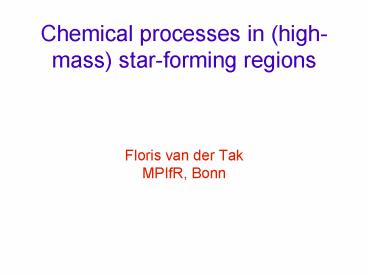Chemical processes in highmass starforming regions PowerPoint PPT Presentation
1 / 19
Title: Chemical processes in highmass starforming regions
1
Chemical processes in (high-mass) star-forming
regions
- Floris van der Tak
- MPIfR, Bonn
2
Outline
- Basic molecular processes
- Models of star-forming regions
- Measuring molecular abundances
- Recent progress
- Future directions
3
Molecular processes gas phase
- Ion-molecule reactions k 10-9 cm3 s-1
- e.g., CO (H3, H2) HCO
- Dissociative recombination k 10-6
- e.g., HCO (e-, H2) CO
- Neutral-neutral reactions k 10-11, EA 0.1 eV
- e.g., O (H2, H) OH (H2, H) H2O
4
Molecular processes solid phase
- Accretion, not reaction limited
- outcome depends on atomic composition of
gas phase - create saturated species unlike
ion-molecule reactions - Low density n(H) gt n(O) hydrogenation
- e.g., CO ... H2CO ... CH3OH
- n gt 104 cm-3 n(O) gt n(H) oxygenation
- e.g., CO ... CO2
- Either case n(D) / n(H) gtgt D/H deuteration
- may also occur in gas phase
5
Gas-grain interaction
- Freeze-out
- n gt 104 cm-3 or AV gt 3
- Thermal evaporation
- pure CO at T 20 K
- pure H2O at T 90 K
- Non-thermal evaporation
- mainly by cosmic-ray spot heating
6
Shock chemistry
- v lt 40 km/s, xe lt 10-6 C-shock
- O into H2O, S into SO SO2
- v gt vA J-shock
- H2 dissociated reformed then as C-shock
- Grain-grain grain-H2 collisions
- erode mantles (CH3OH) and cores (SiO)
7
Star-forming regions All of the above !
- Need multi-point radiative transfer (MC / ALI)
- Bonus can study chemical gradients
8
For example OVRO BIMA maps of NGC 1333 IRAS 2A
- Jørgensen et al 2004 CS, SO, SiO CH3OH on N2H
9
High-mass stars more heating more ionization
Detection of CO and SO toward AFGL 2591
Stäuber et al 2004
10
Modern models chemistry dynamics
Collapsing envelope 31 shells, 207 species,
2337 reactions
Rodgers Charnley 2003
11
Measuring molecular abundances
- Doty et al 2004 The modelers take revenge!
12
High resolution infrared spectroscopyCH4
abundance variations towardNGC 7538 IRS9
P Cygni profiles shifted by 7 km/s Gas-phase CH4
/ H2 4 x 10-6 in inner envelope Outer envelope
CH4 frozen on grains Forms on grains, evaporates
near stars, destroyed in shocks Also possible
absorption by ethane, ethanol, and formaldehyde
ice (Boogert et al 2004a)
13
Space-based infrared spectroscopySpitzer ice
inventory towardlow-mass protostars
High CO2 but low CH3OH abundance dense
pre-stellar core CO2 bending mode profile not
mixed with CH3OH CO and OCN- bands heating to
only 50 K (Boogert et al 2004b)
14
New (sub)mm observations The 800 GHz survey of
Orion-KL
541 features from 929 transitions by 26
species Complex organic species in warm (250 K)
hot core component Possible detection of NH2
radical No sign of dust absorption non-spherical
geometry (?) (Comito et al 2005)
15
Quantum chemical calculations flow tube
experiments no way to make methyl formate
Overall reaction downstream but significant
barriers half-way Reactions of normal
protonated H2CO CH3OH cornerstones of hot core
models ... (Horn et al 2004)
16
Variations in the cosmic-ray ionization rate
Dense clouds 3 x 10-17 s-1 (van der Tak van
Dishoeck 2000) Diffuse clouds 10 x higher
(McCall et al 2003 Le Petit et al
2004) Pre-stellar cores 10 x lower (Caselli et
al 2002)
17
Depletion Deuteration
Multi-deuterated ammonia methanol (Roueff Lis
vdTak Parise et al 2001-5) Highly abundant H2D
D2H (Caselli et al 2003 Vastel et al
2004) Strong link with CO depletion (Bacmann et
al 2002-3) Chemistry in completely depleted
limit (Walmsley, Flower PdF 2004-5) Much
stronger DD in pre-stellar than in protostellar
phase
18
Future directions
- Submillimeter interferometry (ALMA)
- resolve abundance enhancements
- disk chemistry
- Terahertz spectroscopy (Herschel)
- inventory of gas phase
- hydrides other light species
- Mid-infrared spectra maps (JWST)
- complex ice species deuterated ices
- dominant N and S carriers
- Laboratory
- gas-phase reaction rates
- ice feature identification
19
Relevant posters
- Benz et al (High-energy tracers)
- Codella et al (Shock chemistry in outflows)
- Pirronello et al (Grain surface chemistry)
- Rizzo et al (PDR chemistry)
- Wyrowski et al (Deuterium chemistry)
Further reading
http//astrochemistry.net http//rate99.co.uk http
//www.strw.leidenuniv.nl/moldata

